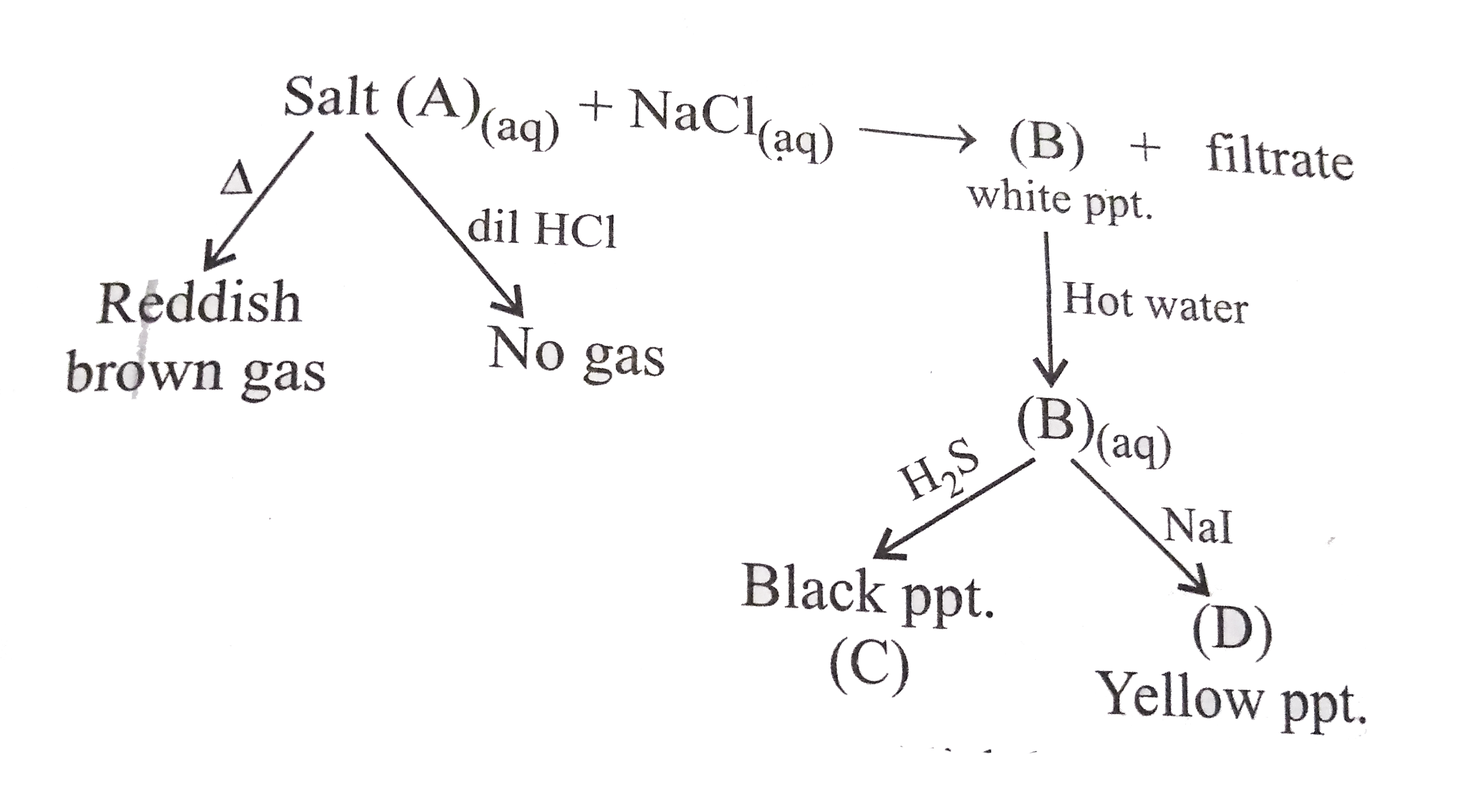An awueous solution of salt (A) gives a give a whes a white precipitate ( B) with sodium chloride solution . Compound ( B) dissolves in hot water and the solution on treatment with souium iodide give a uellow precipitate ( D) ,. and on passing H2S through solution ( B) gives a blck ppt . (C) . Compound (A) does not gvive any gas with dil HCl, but liberates a reddish brown gas on heating identhigy compounds (A), (B), ( C) , and (D) .

Salt (A) on heating libreates reddish brown gas , hence, it contains nitrate.
(B) dissolves in hot water and gives a yellow ppt. with Nal , hence , it is PbCl2 and slt (A) is Pb(NO3_(2).
Pbunderset((A))(NO_(3)_(2(aq)))+2 Na Cl_((aq)) rarrunderset((B))underset("White ppt")(PbCl_(2)darr)+2NaNO_(3(aq))<br>2Pn(NO3)2Δ−−→2PbO+2NO2↑Reddishbrown(B)+3O↑⏐
⏐
⏐
⏐⏐
Pb(nO3)2White ppt(B)Hotwater−−−−−→Pb2+(aq)+2ClΘ(aq)
PbCl2(qa)+2Nal→2Nal→2NaCl+Pbl2↓Yellow ppt.(D)
PbCl2(aq)+H2S→PbS↓+2HClBlack ppt. (C)
Hebnce, (A) is Pb(NO3)2, lead chloride
(B) is PbCl2, lead chloride
(C) is PbS, lead sulphide
(D) is Pbl2, lead iodide.
Topper's Solved these Questions
- P-BLOCK GROUP 14 - CARBON FAMILYBOOK - CENGAGE CHEMISTRYCHAPTER - P-BLOCK GROUP 14 - CARBON FAMILYEXERCISE - Ex (Subjective)
21 Videos
- P-BLOCK GROUP 14 - CARBON FAMILYBOOK - CENGAGE CHEMISTRYCHAPTER - P-BLOCK GROUP 14 - CARBON FAMILYEXERCISE - Ex (Objective)
19 Videos
- P-BLOCK GROUP 14 - CARBON FAMILYBOOK - CENGAGE CHEMISTRYCHAPTER - P-BLOCK GROUP 14 - CARBON FAMILYEXERCISE - Exercises Archives (Subjective)
9 Videos
- P-BLOCK GROUP 13 - BORON FAMILYBOOK - CENGAGE CHEMISTRYCHAPTER - P-BLOCK GROUP 13 - BORON FAMILYEXERCISE - Exercise Archives (Subjecive)
9 Videos
- PERIODIC CLASSIFICATION OF ELEMENTS AND GENERAL INORGANIC CHEMISTRYBOOK - CENGAGE CHEMISTRYCHAPTER - PERIODIC CLASSIFICATION OF ELEMENTS AND GENERAL INORGANIC CHEMISTRYEXERCISE - Exercises (Archives )Subjective
4 Videos
Similar Questions
An aqueous of salt (A) gives a white crystalline precipitate (B) with NaCI solution .The fitrate gives a black precipitate (C) when H2S is passed through it compound (B) dissolve in hot water and the solution gives yellow precipitate (D) an tratement with potassium iodide and on cooling .The compound (A) does not give are gas with dilute HCI but liberates a reddish brown gas on heating identify the compounds (A) to (D) giving the involved equations.
View SolutionAn aqueous solution of salt (A) gives a white crystalline precipitate (B ) with NaCl solution. The filtrate gives a black precipitate (C ) when H2S gas is passed into it. Compound (B) is precipitate (D) with NaI solution and cooling. The compound (A) does not give any gas with dil HCl but liberates a reddish brown gas on heating. Identify the compounds A,B,C and D. Write the chemical equations for varius reactions involved.
View Solution
Knowledge Check
A white salt gives a white precipitate with barium chloride solution which is insoluble in ammonia and hot water. The salt is
ASilver nitrateBMagnesium sulphateCLead AcetateDPotassium chromateConcentrated solution of which salt gives white precipitate with ferric chloride solution:
ANaFBNa3S2O3CNa2CO3DCH3COONaAn aqueous solution of a salt A gives a white crystalline precipitate B with NaCl solutions. The filtrate gave a black ppt. C when H2S gas is passed in it. Compound B dissolves in hot water and the solution gives a yellow precipitate D on treatment with Nal and cooling. The compound A does not give any gas with dilute HCI but liberates a reddish brown gas on heating. Identify the compounds A.
APb SBPb(NO3)2CAgNO3DAgS
An aqueous solution of salt (A) gives a white crystalline precipitate (B ) with NaCl solution. The filtrate gives a black precipitate (C ) when H2S gas is passed into it. Compound (B) is precipitate (D) with NaI solution and cooling. The compound (A) does not give any gas with dil HCl but liberates a reddish brown gas on heating. Identify the compounds A,B,C and D. Write the chemical equations for varius reactions involved.
View SolutionAn aqueous solution of a salt (A) gives a white precipitate
(B) with sodium chloride solution. The filtrate gives a black precipitate
(C ) when H2S is passed into it. Compound (B) dissolves in hot water and the solution gives a yellow precipitate
(D) on treatment with sodium iodide. The compound (A) does gas on heating. Identify the compounds (A) to (D).
Compound B is :
View SolutionAn aqueous solution of a salt (A) gives a white precipitate
(B) with sodium chloride solution. The filtrate gives a black precipitate
(C ) when H2S is passed into it. Compound (B) dissolves in hot water and the solution gives a yellow precipitate
(D) on treatment with sodium iodide. The compound (A) does gas on heating. Identify the compounds (A) to (D).
Compound C is :
View SolutionAn aqueous solution of a salt (A) gives a white precipitate
(B) with sodium chloride solution. The filtrate gives a black precipitate
(C ) when H2S is passed into it. Compound (B) dissolves in hot water and the solution gives a yellow precipitate
(D) on treatment with sodium iodide. The compound (A) does gas on heating. Identify the compounds (A) to (D).
Compound D is :
View SolutionAn aqueous solution of a salt (A) gives a white precipitate
(B) with sodium chloride solution. The filtrate gives a black precipitate
(C ) when H2S is passed into it. Compound (B) dissolves in hot water and the solution gives a yellow precipitate
(D) on treatment with sodium iodide. The compound (A) does gas on heating. Identify the compounds (A) to (D).
Compound A is :
View Solution
